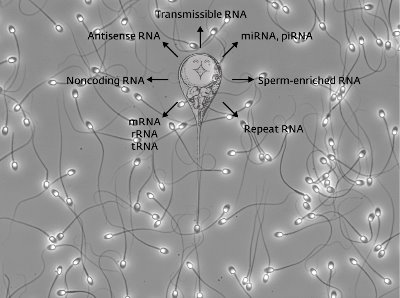Jan. 4, 2013 Research Highlight Biology
Uncovering the role of sperm RNA
Sperm contain small RNAs that may play a part in early post-fertilization development
 Figure 1: Many types of RNAs are known to be present in sperm and studies are now progressing to reveal their functions. © 2012 Mitsuoki Kawano, RIKEN Omics Center
Figure 1: Many types of RNAs are known to be present in sperm and studies are now progressing to reveal their functions. © 2012 Mitsuoki Kawano, RIKEN Omics Center
Sperm give new embryos more than just a copy of their genes: they also contribute RNAs, molecules similar to DNA that play many essential roles in switching genes on or off, and in regulating how much protein is produced from each gene. However, very little is known about sperm RNAs or their functions. Now, a RIKEN team led by Mitsuoki Kawano of the Omics Science Center, Yokohama, Japan, has identified two novel RNAs that may influence the early development of the embryo1.
Kawano, now at Niigata University of Pharmacy and Applied Life Sciences, and colleagues surveyed the RNA complement of mouse sperm using deep sequencing, which identifies both the sequence and frequency of each RNA. The analysis generated over 350,000 RNA sequences, including fragments of ‘coding’ RNAs that are made into proteins (messenger RNAs) and ‘noncoding’ RNAs that perform functions, such as translating genes into proteins (ribosomal RNAs) or silencing genes (Piwi-interacting RNAs (piRNAs) and microRNAs (miRNAs)) (Fig. 1).
The team isolated and examined two of the most abundant of the small noncoding RNAs, dubbed spR-12 and spR-13, which are composed of fewer than 22 bases, or building blocks, and whose precise functions have yet to be determined. To help understand how they might function, Kawano’s group determined how long these small RNAs persist. Both are present in sperm, the newly fertilized egg, and the very early stages of the embryo. Their relative longevity and presence in the nucleus may indicate that they play a role in setting gene expression patterns in the new embryo.
Examination of their structure revealed that spR-12 and spR-13 are part of a unique set of RNAs. “They are different from the well-known piRNA population from testis and miRNA,” says Kawano. Further analysis has revealed a distinct signature for these mature-sperm-enriched small RNAs, which represent a novel class of abundant small RNAs that can be grouped into distinct families. The researchers speculate that these RNAs are produced in a unique manner: unlike other RNAs formed during spermatogenesis, they are trimmed down from their longer precursor piRNA relatives.
Knowledge of which RNAs are usually present in healthy sperm could be used to confirm success of vasectomies, diagnose male infertility, and help to pinpoint environmental factors contributing to the rise in male infertility. “Future work will reveal whether these sperm-enriched small RNAs contribute to development of a fertilized egg,” says Kawano. The researchers are also interested in investigating how factors such as diet, smoking, and stress affect the small RNA profiles in human sperm.
References
- 1. Kawano, M., Kawaji, H., Grandjean, V., Kiani, J. & Rassoulzadegan, M. Novel small noncoding RNAs in mouse spermatozoa, zygotes and early embryos. PLOS One 7, e44542 (2012). doi: 10.1371/journal.pone.0044542
